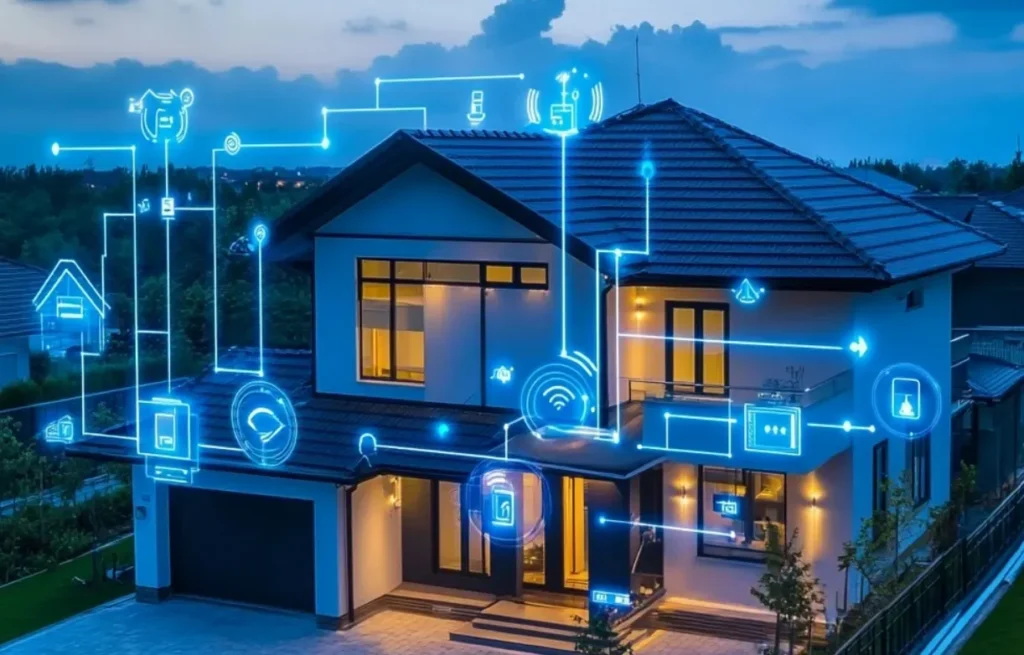The rise of smart homes is transforming how Americans live, relax, and interact with their homes. From voice-controlled lighting to smart thermostats that learn your habits, technology is bringing convenience, efficiency, and security into everyday life.
In the past, home automation was something you’d only see in movies or luxury estates. Today, smart home devices are affordable, widely available, and becoming a common part of modern households across the U.S. In fact, it’s estimated that over 60 million American homes already use at least one smart device.
So, what’s driving this shift? And what does the future look like for smart homes in the United States? Let’s explore the trends, technologies, and transformations behind this growing movement.
What Is a Smart Home?
A smart home is a living space where devices are connected to the internet and can communicate with each other. These devices can be controlled remotely by smartphones, voice assistants like Alexa or Google Assistant, or through automation settings.
Common Smart Home Devices Include:
- Smart speakers (e.g., Amazon Echo, Google Nest)
- Smart lights that adjust brightness and color
- Smart thermostats that adapt to your schedule
- Smart locks and video doorbells for better security
- Smart appliances like refrigerators, ovens, and washing machines
- Smart TVs with streaming and voice controls
- Sensors and cameras for security and automation
The goal? A seamless, personalized, and efficient home experience where technology works for you.
The Rise of Smart Homes in America

The rise of smart homes has been fueled by several factors:
1. Lower Costs and Easy Installation
Thanks to competition and mass production, smart devices are more affordable than ever. Many are plug-and-play, meaning homeowners and renters alike can set them up without professional help.
2. More Connectivity and Voice Assistants
The popularity of voice assistants like Amazon Alexa, Apple Siri, and Google Assistant has made it easier for people to control their smart homes using simple voice commands.
3. Focus on Energy Savings and Sustainability
Smart thermostats, lighting systems, and appliances help reduce electricity use and lower utility bills. As sustainability becomes a bigger concern, more households are adopting these energy-saving tools.
4. Growing Need for Home Security
Video doorbells, motion sensors, and smart locks give homeowners greater peace of mind. With remote access and instant alerts, people can monitor their homes from anywhere.
5. Remote Work and Lifestyle Shifts
The COVID-19 pandemic changed how Americans use their homes. As more people work remotely, smart home devices are helping to improve comfort, productivity, and security throughout the day.
Benefits of Smart Home Technology
The rise of smart homes is more than a trend—it offers real-life benefits that impact daily living:
✅ Convenience
- Control lights, music, or the thermostat without leaving the couch.
- Automate daily routines (e.g., “Good Morning” settings that turn on lights, start the coffee maker, and give you the weather forecast).
✅ Energy Efficiency
- Save on heating and cooling with smart thermostats.
- Automatically turn off lights and appliances when not in use.
✅ Safety and Security
- Get notified when someone rings your doorbell or enters your home.
- Use smart locks to let in guests or service workers when you’re away.
✅ Customization
- Set up schedules and scenes that fit your lifestyle.
- Personalize lighting, music, or temperature settings for different moods.
✅ Increased Home Value
- Smart home features can make homes more attractive to buyers.
- Many real estate listings now highlight smart features as a selling point.
Challenges of Smart Homes
While the rise of smart homes brings many benefits, there are still challenges to consider:
⚠️ Privacy Concerns
Smart devices collect data to learn your habits. Some users worry about how this data is used or shared by companies.
⚠️ Cybersecurity Risks
If not properly secured, smart home systems can be vulnerable to hacking. Using strong passwords, two-factor authentication, and secure networks is essential.
⚠️ Compatibility Issues
Different brands and platforms may not work together smoothly. Choosing products that are compatible with your voice assistant or hub can prevent frustration.
⚠️ Learning Curve
Some users—especially older adults—may find new technology confusing. User-friendly design and support are important for adoption.
Popular Smart Home Trends in 2025 and Beyond
As the technology matures, new trends are shaping the future of the rise of smart homes in the U.S.
1. AI-Powered Automation
Smart homes are getting smarter with artificial intelligence. Devices are learning your habits and preferences to anticipate your needs—like starting the coffee pot before you even get out of bed.
2. Matter Protocol for Better Compatibility
The new Matter protocol, backed by Apple, Google, Amazon, and others, aims to make smart devices work together more easily, no matter the brand.
3. Energy Monitoring and Solar Integration
More homes are combining smart tech with solar panels and energy storage. Real-time energy tracking helps homeowners use energy more efficiently.
4. Smart Kitchens
Smart fridges that suggest recipes, ovens you can preheat remotely, and dishwashers that run during off-peak hours—kitchen automation is on the rise.
5. Voice-First Control
Voice control is becoming the primary interface in many homes. Future devices will rely less on screens and more on natural conversation.
6. Aging-in-Place Technology
Smart homes are helping seniors stay independent longer. Features like fall detection, medication reminders, and remote check-ins support aging in place.
Smart Homes in American Culture and Daily Life
The rise of smart homes is also changing how Americans think about their homes. For many, home is no longer just a place to sleep—it’s an office, gym, entertainment center, and safe haven.
Technology is becoming part of the home’s personality. Whether it’s setting the mood with voice-controlled lighting or receiving grocery reminders from your fridge, smart homes are making everyday tasks easier and more enjoyable.
What the Future Holds for Smart Homes in the U.S.
Here’s what the next 5 to 10 years might look like for U.S. households as the rise of smart homes continues:
🔮 Fully Integrated Ecosystems
Instead of a mix of disconnected gadgets, homes will run on unified systems where all devices work together seamlessly.
🔮 Smarter Infrastructure
New homes will be built with smart wiring, sensors, and systems already installed, making them “smart-ready” from day one.
🔮 Green Homes by Default
Sustainability will be a key driver. Smart homes will be expected to save energy, reduce waste, and support eco-friendly lifestyles.
🔮 Greater Personalization
Smart homes will adapt not just to your schedule but also to your mood, weather, or even your health conditions.
🔮 Rise of Subscription-Based Smart Services
Just like streaming platforms, homeowners may pay for smart home features on a subscription basis, such as home monitoring or maintenance alerts.
Conclusion: Embracing the Smart Home Revolution
The rise of smart homes is reshaping what it means to live comfortably, safely, and efficiently. As technology becomes more affordable and accessible, more U.S. households are embracing this shift.
Whether you’re just starting with a smart speaker or already managing your whole home from your phone, the future of smart living is here—and it’s only getting better.
Smart homes aren’t just about gadgets—they’re about living smarter, saving energy, improving security, and enjoying a home that truly works for you.
Fore More – From Textbooks to Holograms: AR is Changing US Education






